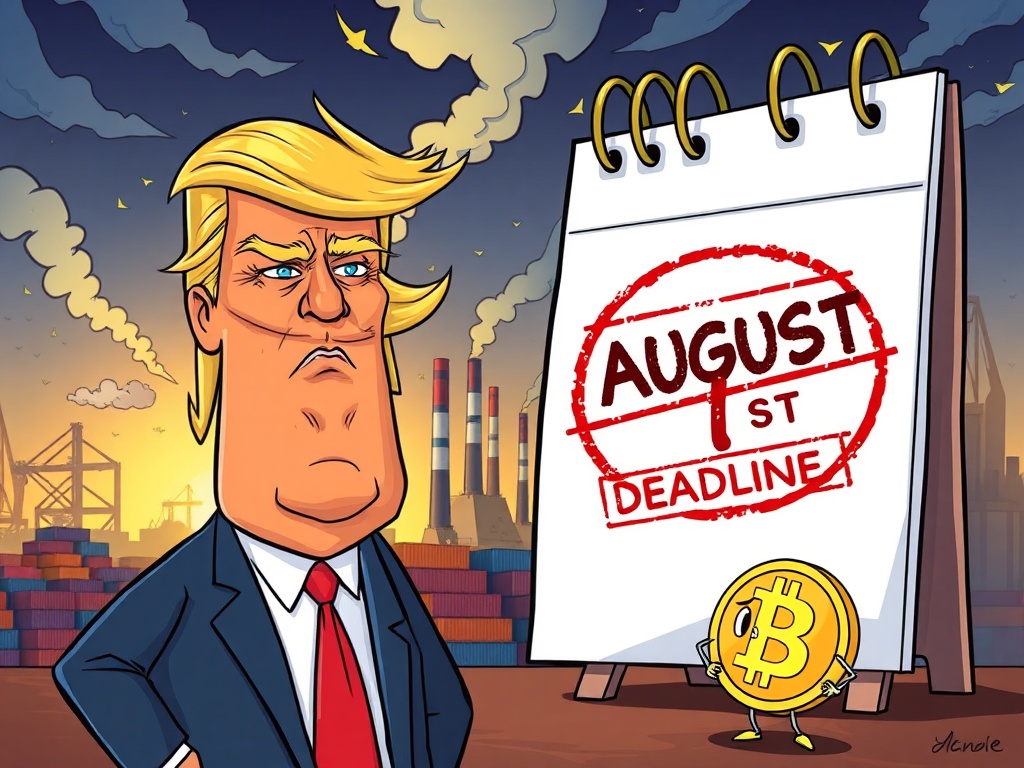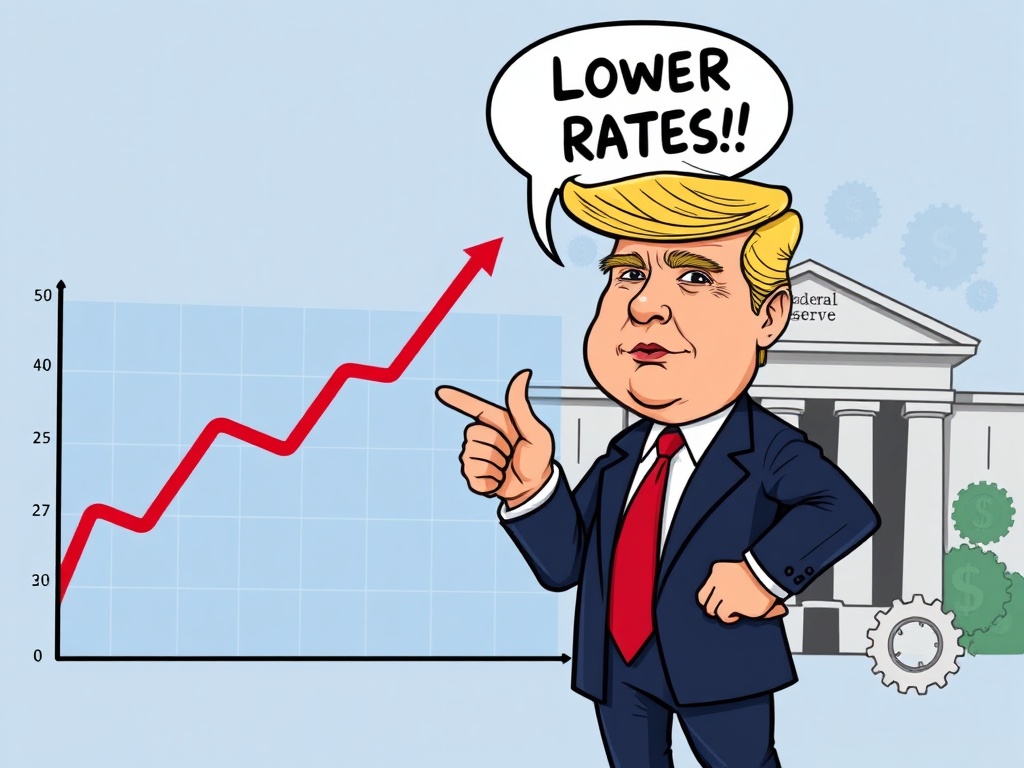BitcoinWorld

Trump Tariff Deadline: A Crucial Economic Warning for Crypto Investors
The digital asset world often finds itself intertwined with global economic and political currents. A recent declaration from U.S. President Donald Trump has sent ripples through financial markets, and it’s crucial for cryptocurrency enthusiasts and investors to understand its potential implications. In a direct post on Truth Social, relayed by Walter Bloomberg on X, President Trump unequivocally stated that the August 1 deadline for ongoing trade negotiations ‘stands strong’ and will not be extended. He even characterized this firm stance as ‘a great day for America.’ But what does this decisive Trump Tariff Deadline mean for the broader economic landscape, and more specifically, for the often-unpredictable crypto market?
Understanding the Trump Tariff Deadline Announcement
President Trump’s latest announcement regarding the August 1 Trump Tariff Deadline underscores his consistent ‘America First’ approach to trade policy. Historically, Trump’s administration has favored aggressive negotiation tactics, often employing tariffs as leverage to secure what he deems more favorable trade agreements. This particular deadline, though not explicitly detailing the specific negotiations it pertains to, signals a firm resolve to conclude or escalate ongoing trade discussions.
- Source of the News: The declaration was made by President Trump himself in a post on Truth Social, subsequently reported by Walter Bloomberg on X, a well-known source for rapid financial news updates. This direct communication method bypasses traditional media filters, giving the announcement immediate weight and authenticity from the President’s perspective.
- The Core Message: The unambiguous statement that the August 1st deadline ‘stands strong’ and ‘will not be extended’ leaves no room for speculation. It indicates a clear intention to push for a swift resolution or to proceed with consequences if demands are not met.
- President’s Stance: Labeling the decision as ‘a great day for America’ suggests a belief that this firm stance will ultimately benefit U.S. economic interests, potentially by securing better trade deals or protecting domestic industries. This sentiment often resonates with his political base and aligns with his broader economic philosophy.
- Immediate Implication: For businesses and markets, this means a period of heightened anticipation leading up to August 1st. Companies involved in international trade, particularly those with exposure to potential tariffs, will be scrambling to assess risks and adjust strategies.
Historical Context: Past Trump Tariff Deadlines and Market Reactions
To truly grasp the potential impact of this new Trump Tariff Deadline, it’s beneficial to look back at previous instances of President Trump’s trade-related pronouncements and their market reverberations. During his previous term, the U.S. engaged in significant trade disputes, most notably with China, but also with allies like the European Union and Canada over steel and aluminum tariffs. These periods were often characterized by a high degree of market uncertainty and volatility, as businesses and investors grappled with unpredictable policy shifts.
Consider the U.S.-China trade war, which spanned several years. The imposition of tariffs on hundreds of billions of dollars worth of goods, from agricultural products to electronics, created immense pressure on global supply chains and corporate profitability. Each announcement, each deadline, and each negotiation round triggered significant reactions in stock markets, commodity prices, and currency valuations.
While the cryptocurrency market was less mature during the peak of these trade wars, it did show interesting patterns. Bitcoin, in particular, sometimes saw spikes in demand as it was perceived by some as an uncorrelated asset or a ‘digital gold’ hedge against traditional financial instability. However, as the crypto market has matured and become more integrated with traditional finance, its correlation with equities has generally increased, meaning major downturns in traditional markets are more likely to drag crypto prices down.
Potential Economic Ripple Effects of the Trump Tariff Deadline
A hard deadline for trade negotiations, particularly one related to tariffs, carries significant weight for the global economy. If agreements aren’t reached by the August 1 Trump Tariff Deadline, several economic ripple effects could ensue, impacting various sectors and potentially leading to broader macroeconomic shifts:
- Supply Chain Disruptions: New or increased tariffs could force multinational corporations to urgently re-evaluate their sourcing and manufacturing locations. This often leads to costly and time-consuming reconfigurations, resulting in delays, higher logistical expenses, and potential shortages of goods. Companies might onshore production or seek new international partners, but these transitions are rarely smooth.
- Inflationary Pressures: Tariffs are essentially taxes on imported goods, and these costs are typically passed on to consumers in the form of higher prices. For example, if tariffs are imposed on raw materials, the cost of finished goods using those materials will increase. This contributes directly to inflation, eroding purchasing power and potentially leading to a decrease in consumer spending.
- Reduced Corporate Earnings: Businesses facing higher input costs due to tariffs, or reduced demand because their products become more expensive, may see their profit margins shrink. This directly impacts corporate earnings, which in turn can lead to lower stock valuations, reduced investment, and even job losses in affected industries.
- Global Economic Slowdown: Widespread trade tensions and protectionist policies can dampen global economic growth. Uncertainty discourages both domestic and foreign investment, as businesses become hesitant to expand or commit capital in an unpredictable environment. This can lead to a contraction in international trade volumes and a general slowdown in economic activity worldwide.
- Currency Fluctuations: Trade imbalances and policy decisions can lead to significant shifts in currency values. For instance, if a country faces new tariffs on its exports, its currency might weaken as demand for its goods falls. Such fluctuations can further complicate international trade and investment, creating additional layers of risk for global businesses and investors.
How the Trump Tariff Deadline Could Influence Crypto Markets
While the immediate focus of a Trump Tariff Deadline might seem squarely on traditional financial markets, the interconnectedness of the global economy means that cryptocurrencies are rarely immune to significant macro-economic shifts. The digital asset space, though decentralized, still operates within a global financial framework that reacts to major economic news. Here’s how a firm August 1 deadline could potentially influence the crypto market:
- Increased Volatility: Economic uncertainty is a primary driver of volatility across all asset classes, and cryptocurrencies, already known for their price swings, could experience even greater fluctuations. Traders might react impulsively to news, leading to sharp price swings as sentiment shifts rapidly between fear and opportunity. Major cryptocurrencies like Bitcoin and Ethereum, as well as smaller altcoins, could see exaggerated movements.
- Risk-Off Sentiment: In times of global economic stress or perceived instability, investors often move away from what they consider ‘riskier’ assets towards ‘safe havens.’ While Bitcoin has sometimes been hailed as ‘digital gold’ and a hedge against inflation or traditional market instability, its correlation with traditional equities has increased significantly in recent years. This means a substantial downturn in traditional stock markets, triggered by trade tensions, could drag crypto prices down as investors liquidate assets across the board to cover losses or move to cash.
- Search for Alternatives and Digital Gold Narrative: Conversely, if traditional financial systems show significant signs of strain, or if fiat currencies experience substantial devaluation due to trade wars and inflation, some investors might increasingly turn to cryptocurrencies as an alternative store of value or a hedge against traditional economic instability. This could potentially drive renewed demand for assets like Bitcoin, reinforcing its ‘digital gold’ narrative, especially if the crisis is perceived to undermine the stability of national currencies.
- Impact on Adoption and Innovation: Prolonged economic uncertainty could either accelerate or decelerate crypto adoption, depending on how the technology is perceived amidst the turmoil. If cryptocurrencies, particularly stablecoins and decentralized finance (DeFi) protocols, offer practical solutions to cross-border payments, remittances, or provide inflation-resistant alternatives, their adoption might grow. However, if the market is seen as too volatile and speculative, mainstream adoption might slow down as cautious investors shy away.
- Liquidity Shifts: Major economic events can cause capital to flow in and out of different markets. A significant shift of funds out of traditional markets could either lead to some capital finding its way into crypto, or it could drain liquidity from crypto as investors prioritize more liquid assets for immediate needs.
Navigating Market Volatility: Actionable Insights for Investors
Given the potential for increased market volatility stemming from the Trump Tariff Deadline, prudent investors should consider adopting a strategic and informed approach. Emotional reactions to market news can often lead to poor decisions. Here are some actionable insights to help navigate these uncertain times:
- Stay Informed and Verify Sources: Keep a close eye on geopolitical developments, economic indicators, and official announcements from credible news sources. Be wary of unverified rumors and always cross-reference information. Understanding the nuances of trade policy and its potential impacts is paramount.
- Diversify Your Portfolio: Don’t put all your digital eggs in one basket. A diversified crypto portfolio, including a mix of established large-cap cryptocurrencies (like Bitcoin and Ethereum), stablecoins, and perhaps some carefully researched altcoins, can help mitigate risks associated with single asset price swings. Consider also diversifying across different sectors within crypto, such as DeFi, NFTs, or Layer 1 solutions.
- Implement Robust Risk Management: Define your personal risk tolerance and stick to it. Avoid over-leveraging in speculative trades, as sudden market movements can lead to rapid liquidations. Consider setting stop-loss orders to automatically limit potential losses during sharp downturns, and only invest what you can afford to lose.
- Maintain a Long-Term Perspective: For many, cryptocurrency investing is a long-term game, focusing on the underlying technology and its potential for future adoption. Short-term market fluctuations, while unsettling, may not significantly impact a well-researched long-term strategy. Avoid emotional trading driven by daily news cycles and focus on your long-term investment goals.
- Utilize Stablecoins Strategically: During periods of high volatility and uncertainty, parking a portion of your funds in stablecoins (cryptocurrencies pegged to fiat currencies like USD) can offer a temporary refuge from market swings. This allows you to preserve capital while waiting for clearer market signals or opportunities.
- Practice Dollar-Cost Averaging (DCA): Instead of making large lump-sum investments, consider investing a fixed amount regularly (e.g., weekly or monthly), regardless of the asset’s price. This strategy can help smooth out the impact of volatility over time, reducing the risk of buying at a market peak.
- Conduct Thorough Research (DYOR): Before making any investment decisions, thoroughly research the projects you are considering. Understand their fundamentals, use cases, team, and community. Informed decisions are always better than speculative gambles.
President Trump’s firm declaration on the August 1 Trump Tariff Deadline introduces a significant variable into the global economic equation. While the immediate focus remains on international trade, the ripple effects are likely to extend into every corner of the financial world, including the dynamic and often sensitive cryptocurrency markets. Investors should prepare for potential increased volatility and remain vigilant, adapting their strategies to navigate the evolving landscape. Understanding these macro-economic shifts is not just about anticipating price movements; it’s about making informed decisions in an increasingly interconnected global economy.
Frequently Asked Questions (FAQs)
Q1: What is the significance of the August 1 Trump Tariff Deadline?
A1: The August 1 deadline signifies President Trump’s firm stance that ongoing trade negotiations will not be extended. This indicates a potential escalation of trade tensions or the finalization of agreements, which can have significant global economic consequences, including impacts on supply chains, inflation, and market stability.
Q2: How have past trade disputes under Trump impacted financial markets?
A2: Past trade disputes, particularly the U.S.-China trade war, led to considerable market uncertainty and volatility. Stock markets experienced fluctuations, global supply chains were disrupted, and there were shifts in demand for various assets. While crypto markets were less mature then, they also showed reactions, with Bitcoin sometimes acting as a perceived hedge.
Q3: Why should cryptocurrency investors pay attention to trade policy announcements?
A3: Global economic policies, like trade tariffs, influence overall market sentiment, investor risk appetite, and the stability of traditional financial systems. As the crypto market becomes more integrated with the broader economy, these macro-economic shifts can directly impact cryptocurrency prices, liquidity, and investor behavior.
Q4: Will the Trump Tariff Deadline cause a crypto market crash?
A4: While a direct ‘crash’ is not guaranteed, the Trump Tariff Deadline could contribute to increased market volatility and a potential ‘risk-off’ sentiment, which might lead to price corrections in the crypto market. The extent of the impact depends on the specific outcomes of the trade negotiations and broader market reactions.
Q5: What are some strategies for crypto investors during periods of economic uncertainty?
A5: Key strategies include staying informed, diversifying your portfolio, implementing robust risk management (e.g., stop-loss orders), maintaining a long-term investment perspective, strategically utilizing stablecoins, and practicing dollar-cost averaging (DCA). Always conduct your own thorough research (DYOR).
Q6: Is Bitcoin considered a safe-haven asset during trade wars?
A6: Bitcoin’s role as a safe-haven asset during trade wars is debated. While some argue it acts as ‘digital gold’ against fiat currency devaluation or traditional market instability, its correlation with traditional equities has increased. Its safe-haven status can depend on the specific economic conditions and investor perception at the time.
If you found this analysis insightful, consider sharing it with your network! Help others understand the critical connection between global economic policies and the dynamic world of cryptocurrencies. Your shares help us continue providing valuable insights.
To learn more about the latest crypto market trends, explore our article on key developments shaping Bitcoin price action.
This post Trump Tariff Deadline: A Crucial Economic Warning for Crypto Investors first appeared on BitcoinWorld and is written by Editorial Team





